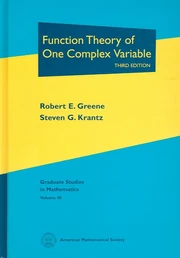
AMS Graduate Studies in Mathematics 40, 1997
"First of all, we have developed the idea that an introductory book on this subject should emphasize how complex analysis is a natural outgrowth of multivariable real calculus. Complex function theory has, of course, long been an independently flourishing field. but the easiest path into the subject is to observe how at least its rudiments arise directly from ideas about calculus with which the student will already be familiar. We pursue this point of view both by comparing and by contrasting complex variable theory with real-variable calculus.
Second, we have made a systematic attempt to separate analytical ideas, belonging to complex analysis in the strictest sense, from topological considerations. Historically, complex analysis and topology grew up together in the late nineteenth century. And, long ago, it was natural to write complex analysis texts that were a simultaneous introduction to both subjects. But topology has been an independent discipline for almost a century, and it seems to us only a confusion of issues to treat complex analysis as a justification for an introduction to the topology of the plane."
Chapter 1 : Fundamental Concepts[]
Chapter 2 : Complex Line Integrals[]
Chapter 3 : Applications of the Cauchy Integral[]
Chapter 4 : Meromorphic Functions and Residues[]
Chapter 5 : The Zeroes of a Holomorphic Function[]
Section 5.1 : Counting Zeroes and Poles[]
Section 5.2 : The Local Geometry of Holomorphic Functions[]
Section 5.3 : Further Results on the Zeros of Holomorphic Functions[]
Section 5.4 : The Maximum Modulus Principle[]
Section 5.5 : The Schwarz Lemma[]
Chapter 6 : Holomorphic Functions as Geometric Mappings[]
Chapter 7 : Harmonic Functions[]
Chapter 8 : Infinite Series and Products[]
Chapter 9 : Applications of Infinite Sums and Products[]
Chapter 10 : Analytic Continuation[]
Section 10.1 : Definition of an Analytic Function Element[]
- I've found the presentation of this construction confusing here and elsewhere, because the equivalence relation tricks me into thinking that something different is about to happen. It seems helpful to outline what we're going to do before we do it. A function element is a pair (f, U) where U is some disc in the complex plane and f is a holomorphic function with domain U -- equivalently, we can think of a power series and the disc on which it converges. (This is also called a germ.) Two function elements (f, U) and (g, V) are direct continuations of each other if U and V have nonempty intersection and f and g agree on this intersection (so that there is a holomorphic function on the union which agrees with both f and g where defined). A particular function element (f, U) generates a subset F of G, where F is the minimal subset containing (f, U) and containing all direct continuations of its elements. Note that, in general, this will likely contain function elements (g, V) and (h, V) where g and h are distinct functions. F is called a global analytic function, and its elements are called branches of F. With this outline in place, I find that the textbook presentation now makes sense to me.